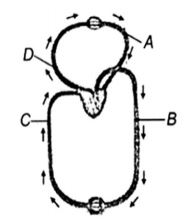Breathing and Exchange of Gases
- The carbon dioxide is transported via blood to lungs as
-
View Hint View Answer Discuss in Forum
Carbon dioxide is transported via blood to lungs mostly as carbaminohaemoglobin and carbonic acid. It is released in lungs in exchange with oxygen.
Correct Option: D
Carbon dioxide is transported via blood to lungs mostly as carbaminohaemoglobin and carbonic acid. It is released in lungs in exchange with oxygen.
- Although much CO2 is carried in blood, yet blood does not become acidic, because
-
View Hint View Answer Discuss in Forum
CO2 enters RBC and reacts with water to form carbonic acid. Carbonic acid dissociates to form bicarbonate and hydrogen ions. Some bicarbonate ions are transported in erythrocytes while some diffuse into the blood plasma. Exit of bicarbonate ions change the ionic balance between the plasma and erythrocytes. To restore this balance chloride ions diffuse from plasma into erythrocytes. Due to this the pH of blood is maintained.
Correct Option: B
CO2 enters RBC and reacts with water to form carbonic acid. Carbonic acid dissociates to form bicarbonate and hydrogen ions. Some bicarbonate ions are transported in erythrocytes while some diffuse into the blood plasma. Exit of bicarbonate ions change the ionic balance between the plasma and erythrocytes. To restore this balance chloride ions diffuse from plasma into erythrocytes. Due to this the pH of blood is maintained.
- Figure shown schematic plan of blood circulation in humans with labels A to D. Identify the label and give its function’s.

-
View Hint View Answer Discuss in Forum
A is pulmonary vein which takes pure blood from lungs to heart. B is dorsal aorta which takes pure blood from heart to various body parts. C is vena cava which takes impure blood from various body pars to right auricle of the heart. D is pulmonary artery which takes impure blood from heart to lungs.
Correct Option: B
A is pulmonary vein which takes pure blood from lungs to heart. B is dorsal aorta which takes pure blood from heart to various body parts. C is vena cava which takes impure blood from various body pars to right auricle of the heart. D is pulmonary artery which takes impure blood from heart to lungs.
- Intercostal muscles occur in
-
View Hint View Answer Discuss in Forum
Intercostal muscles (external intercostal & internal intercostal) are attached with the ribs which help in the movement of rib cage during breathing.
Correct Option: C
Intercostal muscles (external intercostal & internal intercostal) are attached with the ribs which help in the movement of rib cage during breathing.
- The alveolar epithelium in the lungs is
-
View Hint View Answer Discuss in Forum
The very thin alveolar wall (about 0.0001 mm) is composed of moist, non– ciliated, squamous epithelial cells
Correct Option: B
The very thin alveolar wall (about 0.0001 mm) is composed of moist, non– ciliated, squamous epithelial cells

